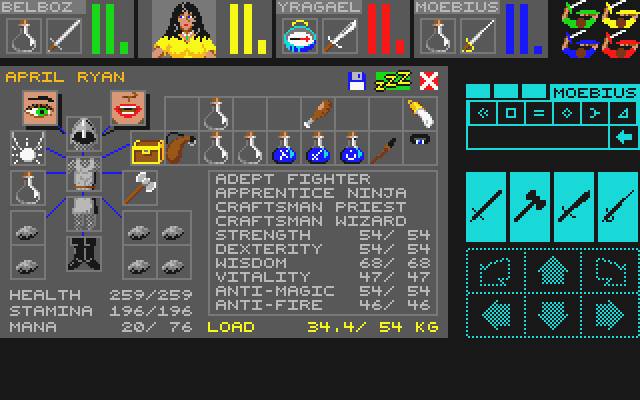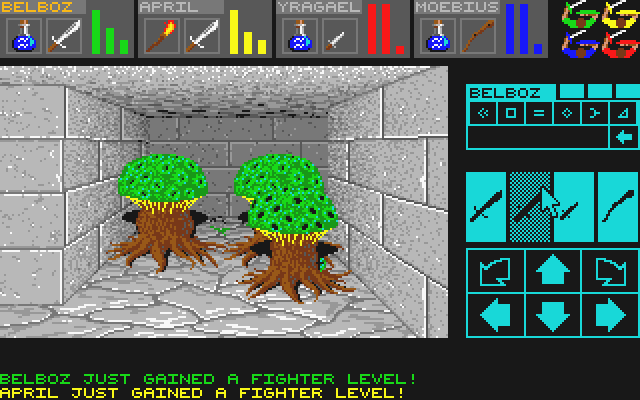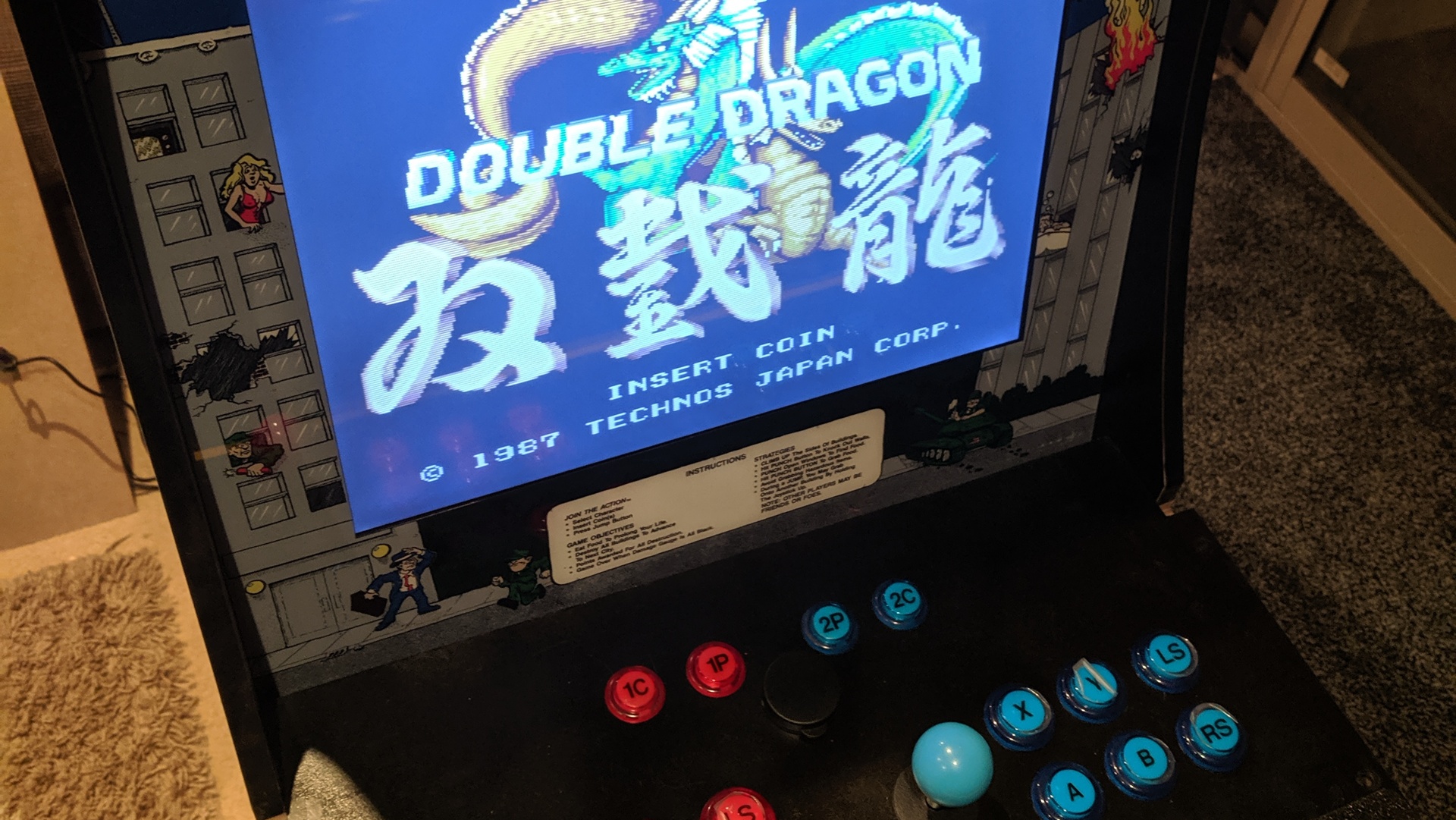Greatest Games is a feature where we highlight our favourite games from the past and try to explain what we think makes them great and worth searching out to play again. If you’ve got your own thoughts on the subject, please feel free to share them in the comments below.

The box art for Dungeon Master famously shows four of the game’s champions about to meet an untimely fate.
Back in 1987, FTL Games released Dungeon Master for the Atari ST; the game was a real time 3D perspective role playing game that let players travel through a detailed dungeon searching for the mystical Firestaff with which to eventually defeat the evil Lord Chaos.
Movement in the game was based on you traversing a 2D grid but your perspective was being rendered from a 3D point of view. Each step you would take was literally a square on a grid and depending on the direction you were facing the perspective view would change. Games had done this before since the early days of RPGs but not at the fidelity or degree of interaction that DM first achieved.
Up to four characters could be included in your party and were selected at the beginning of the game by viewing portraits lined up in a “Hall of Champions”. In the game world, your party would occupy that single grid space in a 2×2 arrangement that would factor in to combat and how the world interacts with you.
The real time aspect of the game ensured that you couldn’t sit still for too long. Monsters would often wander corridors and could catch you while you rested. Some monsters would respawn ensuring no area was completely safe.
Your torch, the only light source you have initially, was a finite resource that burns out after a while making it very difficult to see. And your characters could starve and die, which forced you to keep moving and keep a good stock of provisions. Thankfully in that situation some monsters even made for handy travel munchies if you knew where to look.
What all this amounted to was a game that kept players on their toes and challenged for hours on end in a way that was almost revelatory. On the ST, the game was a smash hit and became the all time best selling title on the platform. Of the subsequent versions released, the Amiga one gets a boost through its innovative use of 3D sound effects and an in game map scroll that ST players wouldn’t see until the expansion Chaos Strikes Back. But even the PC and later SNES versions acquit themselves well so whichever platform you have available you will be able to play the game well.
Why do I think it deserves such praise? Here’s why…
#1 The world seems alive and you can touch it
Each level was studded with traps, doors, treasure and of course monsters. At any point you might be required to find a key, flip a lever or trigger a trap to beat a puzzle and reach the next set of stairs leading you further down and closer to your goal. What was great about all of this is that everything runs in real time and requires you to actually interact with them so you could flip a switch and turn around to see a portcullis raising up down a corridor. Or see a fireball come streaming your way…
Items and monsters also would physically inhabit the space as well, so a pressure switch could be triggered by the weight of one or you could throw a rock at it for the same effect. That your inventory items had physical weight to it beyond encumbrance was a surprise that you might only discover by accident.
I remember back to an early play through where one of my four characters died during a fight with a mummy, spilling their inventory on the ground. Running out of weapons and projectiles I proceeded to pick things up and fling them at the mummy, eventually winning. How many games can lay claim to turning a block of cheese into a deadly weapon?
And it wasn’t just flying cheese you or your enemies needed to fear – projectiles were a big part of combat in the game as arrows, knives and stars could be used to attack enemies from a distance. And if you were proficient enough in magic, fireballs and poison clouds to cause strife too
#2 Your place in that world makes sense
Not long after you get your party of champions together in their 2×2 formation and start on your quest you will likely to either run into a wall, get hit by a door as it closes or fall down a pit. And when it happens, your team will get damage as befitting the situation such as your two characters closest to a colliding wall will take the hit.
Character positions were also something that you had to be mindful of in combat with the two in the front of an encounter being the first to take mêlée damage. Thus you needed to ensure you had an arrangement that had your toughest (usually fighters) at the front and kept your weaker ranged combatants at the rear.
But that didn’t always protect you thanks to opponents often attacking you from the side or rear which meant you had to be ready to turn or switch formation as required to get you party in the best position to fight back. Being blindsided was also a key ploy of the thief, who seemed to relish running off with your character’s gear at the worst possible times.
But as you learned to deal with these issues, you’d find that the monsters were in the same situation as you and could fall victim just as easily. Smashing them with doors or dumping them down pits were as effective means of victory as a sword or fireball.
#3 Characters weren’t bound to classes

The character screen was a gold standard for what was to come in future games. In this case, we have someone set up as a support character.
Though the characters in your party would all have attributes leaning towards certain paths such as a fighter (mêlée weapons), ninja (ranged weapons), priest (potions) or wizard (spell casting) they could still be versed in all the skillsets and gain levels if they used them often. This was a method that would be used later in The Elder Scrolls series.
The ability to multiclass was great as it allowed you to have a couple of specialist characters backed up by all rounders. Having everyone able to make health potions or cast light spells would help to free up your priests or wizards to focus on the more complex spells. And as it was also likely those characters were positioned behind your stronger fighters, kitting them out with bows, slings or other projectiles
#4 It was tough but fair
Though the game could be punishing at times, it didn’t prevent you from recovering from too many situations. Located on a handful of levels was an “Altar of Rebirth” that allowed you to place the remains of one dead character (conveniently reduced to a skeleton) and have them revived at minimal health. There was no limit to how often this could be used but you always had to have at least one of your four characters alive to take them there.
You might have heard of the popular game mechanic popularly called the “corpse run”, Dark Souls players are no doubt familiar with it, where your resurrected characters would head back to the place of their death to collect lost gear. It was something that DM players faced on a regular basis.
Puzzles were almost always introduced to players via a sign on a wall that hinted at the solution to the problem. From dropping items to navigating teleporters, the game would quickly accept your triumphs and move you on to the next challenge.
#5 It was a catalyst for a whole genre in role playing games
At a time when 8bit computer platforms were still a big part of the market, Dungeon Master showed that the newer 16bit machines could create an experience that was difficult to recreate on the older ones. It was hard to argue with a game in that pushed not only graphics and audio but made mouse control an integral part of the experience. It may not have been the first but it was the one that showed how to really make it work.
Understandably, it’s success lead to an explosion of similar 3D dungeon crawlers including Bloodwych (with 2 player onscreen co-op), Captive (a Sci-Fi dungeon crawler), the Ishar series and finally the Eye of the Beholder series which brought the genre into the world of Dungeons and Dragons.
FTL did release a follow up game called Chaos Strikes Back that used the existing game engine but contained a new set of levels and even more monsters to face. A bonus with the game was a utility disk that provided hints to the more challenging puzzles and also a means to import your existing characters from DM and modify their portraits. For those looking for a bigger challenge, its higher difficulty made for many more hours in the depths.
Unfortunately it was the last we saw of DM for some time. When they finally released a true sequel with Dungeon Master II: The Legend of Skullkeep in 1995 (though 1993 in Japan), interest in that style of game was on the wane. To put it in perspective (pun intended), Wolfenstein 3D had come out in 1992 followed by Doom a year later and PC gaming had begun to inch towards a technology arms race that left many games in their wake. Grid based movement at this time had become out-dated.
Though many games may have “advanced” past this in the following years by providing even better first person experiences, there are some developers who still see the merits of the old design. Almost Human’s Legend of Grimrock and its sequel are a modern interpretation of the mechanics pioneered in Dungeon Master and others of the genre. They really “get” what makes it work and it pays off for them in spades.
And if you think that the genre was not well represented, check out this list as there are plenty of games out there influenced by what Dungeon Master achieved almost thirty years ago.
Not bad for a “dungeon crawler”.
Categories: Gaming, Greatest Games, Opinion






It’s amazing to see what developers were able to do with such crude tools. They made their games meaningful and immersive with a tiny fraction of what is available today.
Great read.
LikeLiked by 2 people
Thanks for the feedback, glad you liked it! I also am impressed with what game devs were able to come up with on hardware of the era… Makes you realise how far things have progressed since then.
LikeLiked by 1 person
Yeah great read mate. I remember Dungeon Master and was so hooked on the game. I played it on the Amiga 500 though 🙂
When Eye of the Beholder came out I was even more blown away…
LikeLiked by 1 person